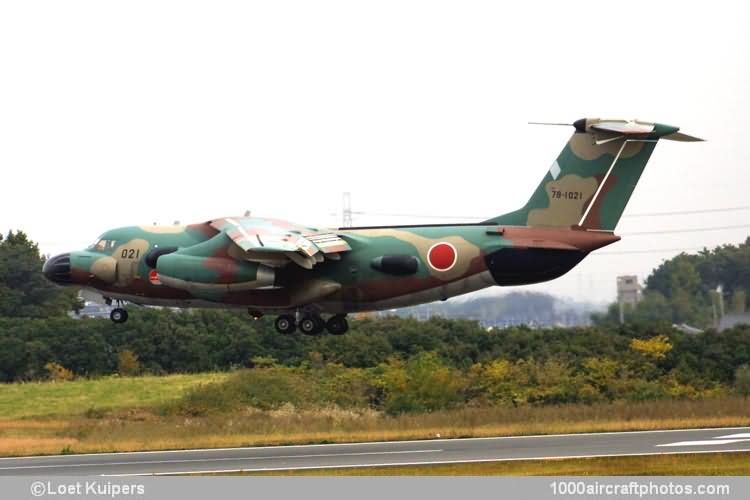The first flying prototype, assembled at Kawasaki's Gifu factory, made its first flight on November 12, 1970, followed by the second on January 16, 1971. These were handed over to the JDA (Japan Defense Agency) on February 24 and March 20, 1971 respectively. Further development and evaluation tests by the JDA were completed in March 1973. Two pre-production aircraft had been delivered by the end of February 1974. Airframe fatigue testing by the JDA was completed in November 1974.
Eleven production C-1s were delivered between December 1974 and the end of March 1976. An additional thirteen C-1s were ordered during FY 1975; these had all been delivered by the end of February 1978, including two long-range aircraft with an additional 1,250 gal (4,732 l) wing center section fuel tank. Two more long-range C-1s were ordered during FY 1977, and one in FY 1979; production ended in 1981 with the delivery of the 31st aircraft, by that time the initial bare metal finished C-1s were camouflaged.
Prime contractor in the C-1 program was Kawasaki, which built the front fuselage and wing center section and undertook final assembly and flight testing. Major subcontractors were Fuji (outer wing panels); Mitsubishi (center and aft fuselage sections and tail surfaces); Nihon Hikoki (Nippi) (flaps, slats, spoilers, ailerons, engine pylons and pods); and Shin Meiwa (cargo loading equipment). Mitsubishi also produced the 14,500 lb (6,577 kg) st Pratt & Whitney JT8D-M-9 turbofan engines under license.
The type carries a crew of five, comprising pilot, co-pilot, navigator, flight engineer and load supervisor on the pressurized and air-conditioned flight deck and main cabin. Standard complements are as follows: troops (max) 60, paratroops (max) 45, stretchers 36 plus attendants. As a cargo carrier, loads can include a 2½ metric ton (5,512 lb, 2,500 kg) truck, a 4.13 in (105 mm) howitzer, two ¾ metric ton (1,653 lb, 750 kg) trucks or three jeeps. Up to three preloaded freight pallets, 7 ft 4 in (2.24 m) wide and 9 ft 0 in (2.74 m) long, can be carried.
A JASDF C-1 was retrofitted by the Technical Research and Development Institute of the JDA as a flying test bed which was used from August 1982 to flight test the XF3 turbofan engine for the Kawasaki XT-4. The same aircraft was used to flight test the FJR710/600S high bypass turbofan engine that powered the NAL (National Aerospace Laboratory) Asuka, an experimental four-engined quiet STOL aircraft, utilizing the airframe of a C-1, that first flew October 28, 1985.
Under a March 1983 Defense Agency contract, Kawasaki modified the 21st production C-1 for use as an ECM training aircraft. Known as the EC-1, it first flew on December 3,1984 and was handed over to the JASDF's Air Proving Wing in late January 1985 for evaluation. Between April 1985 and March 1986, the Air Proving Wing completed about 100 test flights, and in June 1986 the EC-1 was transferred to the JASDF's Electronic Warfare Training Unit.
Equipped with a domestically built TRDI/Mitsubishi Electric XJ/ALQ-5 ECM system, the pictured sole EC-1 has large flat bulbous nose and tail radomes, a blister on each side of the forward fuselage aft of the flight deck side windows, others on each side of the rear fuselage, and two antennae beneath the fuselage."
The following data relates to the C-1 transport.
Span: 100 ft 4.75 in (30.60 m)
Length: 95 ft 1.75 in (29.00 m)
Height: 32 ft 9.25 in (9.99 m)
Wing area: 1,297 sq.ft (120.5 sq.m)
Weight empty: 54,410 lb (23,320 kg)
Max payload: 26,235 lb (11,900 kg)
Max T/O weight: 99,210 lb (45,000 kg)
Max speed: 501 mph (806 kmh) at 25,000 ft (7,620 m)
Cruise speed: 408 mph (657 kmh) at 35,000 ft (10,670 m)
Climb: 3,500 ft (1,065 m)/min
Service ceiling: 38,000 ft (11,580 m)
Range: 807 mls (1,300 km) at 17,416 lb (7,900 kg)
